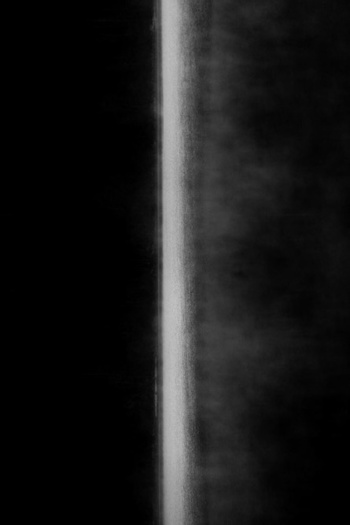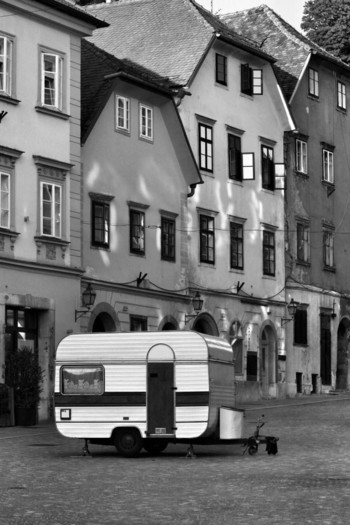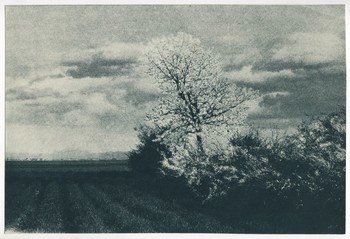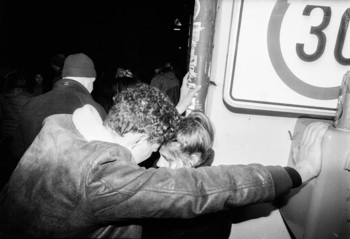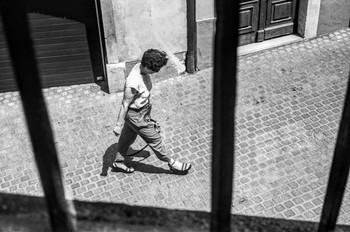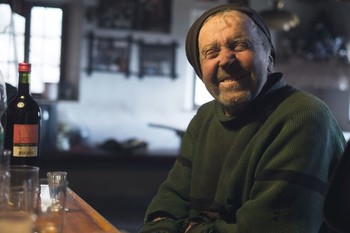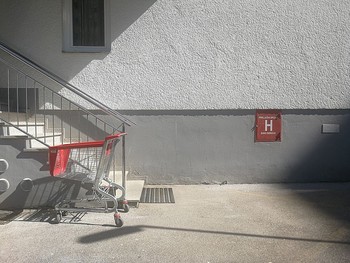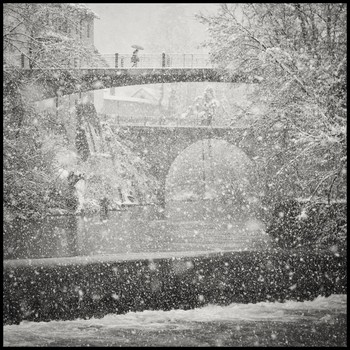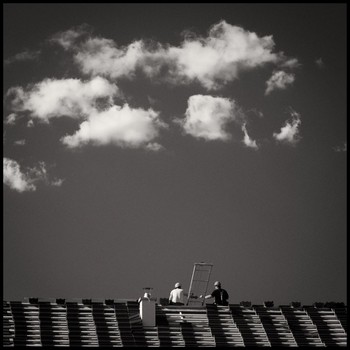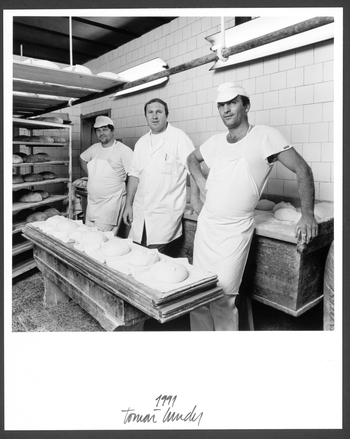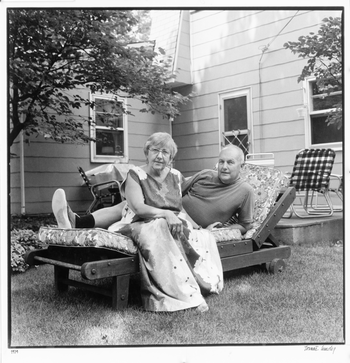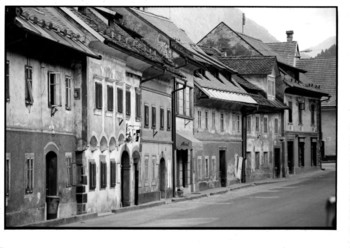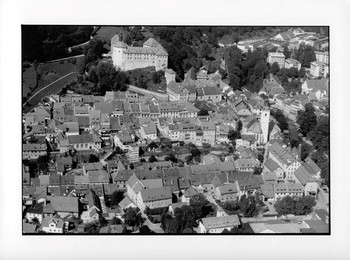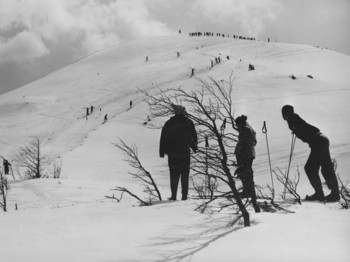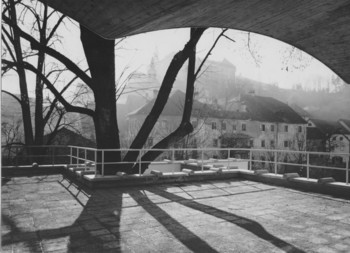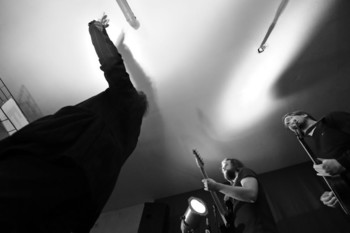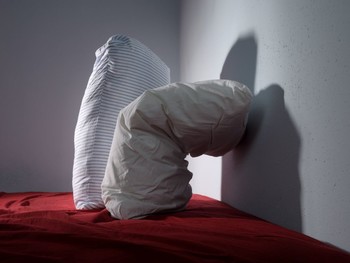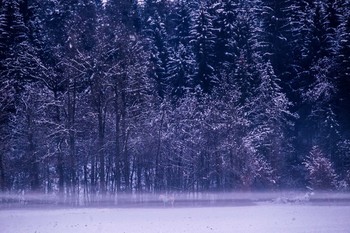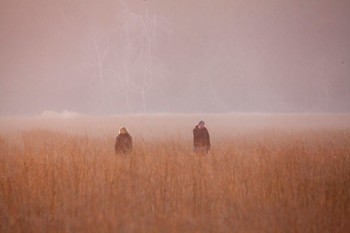Urban Babnik
Urban Babnik (1975) is an informal chronicler of everyday life and the banalities of his immediate environment. His photographs are often humorous and ironic and thus typical of modern street photography which holds up a critical mirror to the social and political aspects of everyday life through capturing banal and/or absurd situations in public spaces. By way of exposing certain motifs, Babnik emphasises their ubiquity, ordinary and everyday character, familiarity and, often, nonsensicality. Although taken locally, Babnik's photographs represent the global essence of contemporary life that is prevalent and largely identical all over the world, a consequence of consumerism that has seeped into every pore of modern society, populating both urban and rural areas with elements of the same type, such as ads, shops, amusement parks, sports centres and tourist hubs.
Avgust Berthold
Avgust Berthold (1880–1919) was only able to pursue photography for a relatively short time, yet he is nevertheless considered one of Slovenia’s most advanced professional photographers and a pioneer of artistic photography. He grew up in Puštal Castle close to Škofja Loka, so his artistic development was greatly influenced by the artists and cultural eminences he befriended there, including painters Ivan Grohar and Rihard Jakopič. In 1905, he opened a photography studio in Ljubljana, where he took portrait photos of both well- and lesser-known people, as well as shot stills of popular natural and cultural sights, distributing them in the form of postcards. In addition to working in the photo imaging industry, he took original photographs, primarily intended for exhibitions. Like most photographic artists in the early 20th century, Berthold followed a specific creed – photographic pictorialism, which he was faithful to between 1904 and 1911, a period when he was also a prolific exhibitor at international photographic events. This exhibition highlights his versatility and includes his pastoral landscape motifs, which have been presented at various exhibitions, as well as his portrait, landscape and personal works.
Mito Gegič
Mito Gegič (1982) is primarily a painter, with photography serving as his sketchbook and aid to creating a visual diary. His paintings focus mainly on the transfer of the digital image onto the material canvas and comment on the cacophony of visual pollution in everyday life. As a photographer he mostly uses analogue process of developing photographs, so his view is necessarily sharpener due to the limited number of attempts to take a photo. The exhibition presents two very different works: on the one side is a triptych with the artist's self-portrait, representing a dark mise-en-scène of trophy images, and on the other is a set of street photographs he created as a diary of getting to know and visually analysing Škofja Loka, a town he moved to and still lives in.
Jana Jocif
Jana Jocif (1982) is a versatile photographer and is, despite her varied professional interests, closely involved in local events and life, as she seeks out and records both public events and the hidden and unknown parts of Škofja Loka’s life. An architect by trade, photography has been her passion since her youth, partly due to her two informal mentors, Tone Mlakar and Peter Pokorn st. This exhibition presents two different segments of her eclectic work. In her series SpreHOT (2020), created during the spring covid-19 lockdown, when public life came to an abrupt stop and contacts between people became extremely restricted, she immortalized the isolation with photographs of her immediate surroundings. The second part features the now deceased Jože Završnik from the settlement Staniše in Poljanska valley, who lived on the fringes of society in a different kind of isolation for many years and was the subject of Jana Jocif’s 2015 picturesque photo essay.
Sašo Kočevar
Sašo Kočevar (1981) is a tireless chronicler of everyday spaces and situations in his environment. In doing so, he uses a variety of the genre’s stalwarts, from street photography to landscape photography, and follows photography’s classic postulates. For the most part, his photos are in black and white, which makes them universal and timeless. Technical aspect plays an important part of his creative practice, and he often seeks ideal proportions and canonized formal effects, such as light playing on the surfaces, reflections, contrasts, the artistry of man-made structures, and natural forms. Kočevar's photography is also inextricably linked to his active lifestyle, centred on mountaineering. The exhibition focuses on a tiny yet diverse slice of his extensive personal archive, presenting photos that continuously and sometimes almost impressionistically record the pulse of Škofja Loka.
Tomaž Lunder
Tomaž Lunder (1955–2016) is considered a pioneer of contemporary photography in Slovenia. He introduced a new type of aesthetic into his eclectic and subjective photography that sought to reflect everyday life. As a photographer and artist, he – always from his subjective standpoint – devoted himself to socially conditioned themes, portraying both familiar people and strangers in his immediate surroundings in order to show the unadorned reality of his generation. He saw photography as a recognisable and representative imprint of a cultural code that testifies to its motifs, be it portraits of people or a cultural landscape. He enriched Slovenian art with his artistic perspective which testifies to the state of mind of both space and time. This exhibition is only showcasing a part of his rich visual production, though one that, according to the principle of pars pro toto, can be recognised as emblematic of his entire oeuvre. The series of portraits of Škofja Loka craftsmen from 1991 is a historical document about various professions at a turning point, when Slovenia entered a turbulent period of social and economic transition. A part of his long-term series titled Friends meanwhile combines images of American and Slovenian everyday lives to create an exceptional visual record of globalised space and time.
Janez Misson
Janez Misson (1963–2019), who finished the Secondary School of Photography in Ljubljana, was a cameraman and photographer who worked in various fields of image creation. He started off as a photo lab assistant at the University Clinic in Golnik and then worked as a cameraman for Slovenia's national broadcaster RTV Slovenia, mostly covering cultural and sports events, and as a professional and artistic photographer. Škofja Loka and the surrounding area were the primary inspiration and source of photography subjects for his photographic work. The exhibition thus includes some of the town's most iconic images, which have been featured on both postcards and at exhibitions. In the early 1990s, Mission flew over Škofja Loka with a motorised two-seater hang-glider operated by Janez Prevodnik and photographed the town from a bird's eye view.
Tone Mlakar
Tone Mlakar (1921–2020) was a versatile artist who worked in Škofja Loka and a wider surrounding area throughout his career until he retired. He was an architect by trade, one of the last to study under the mentorship of Jože Plečnik, as well as a photographer and set designer. During his studies, he created the set designs for some of the first Slovenian feature films, such as Na svoji zemlji (On Our Own Land), Kekec and Balada o trobenti in oblaku (The Ballad of the Trumpet and the Cloud). He also left an indelible imprint on the local environment with his architecture-related work. During his 30-year career at the SGP Tehnik architecture firm, he designed various important modern buildings, such as the Škofja Loka bus station complex, the Kino Sora building and the Novi svet housing estate. He was also involved in the restoration of Ajman Castle near the village of Sveti Duh. He documented some of these projects by means of photography during the development stage, the rest of his photographic work, however, consists mainly of photos showing the pastoral landscape of Škofja Loka and the surrounding area. Mlakar's photographic oeuvre is a one-of-a-kind chronicle of the town and its people, as well as the ever-changing urban and rural cultural landscape.
Janez Pelko - On
Janez Pelko - On (Him) (1968) started pursuing photography in the late 1980s. He was primarily interested in concert photography, taking photos as mementos for his personal archive, later, however, he also worked as a professional photojournalist for the Gorenjski glas newspaper. Throughout his long and varied photographic career, he has been interested in, among other things, exploring the human body and distorting its organic image. The exhibition presents two of his cycles, portraying him first and foremost as a music fan and only then as a photographer documenting music. The documentary photographs of Ensemble Ankaran, which are exhibited for the first time, show the ensemble members' socialising, their rehearsals and performances, with the photographer himself rounding off the ensemble in the mystical role of a protagonist called On (He). The series of photographs titled Terezijanske is directly related to the ‘Same Babe’ band's video Terezijanska, whose concept was conceived by Pelko, who also acted as a screenwriter and director. Both the video and the photographs primarily support the music, however, by dealing with ordinary and everyday subjects, the author adds a humorous and almost surreal dimension.
Peter Pokorn sr.
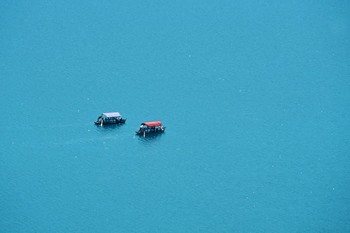
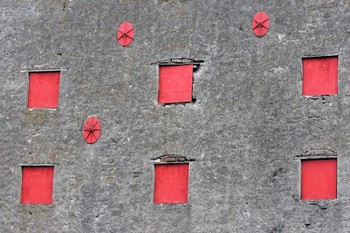
Peter Pokorn Sr. (1939–2016) was a chronicler of the town where he was born in and worked all his life. He was interested in capturing all events happening in Škofja Loka, and thus focused on varied and diverse subjects. His primary passions were landscape, cultural heritage, natural and art photography, where he mainly investigated the artistic issues in motifs. He sought balance and dynamism in his depictions of the landscape, but, being an architect by education, he was well aware that composing artistic elements was also a key skill in photography. He had delved continuously and in depth into some areas – for example, he sought, researched, documented and added for decades to his collection of hayracks found from the Dolomites to Croatia as part of Europe's rural cultural heritage. He was also involved in sports photography and was a permanent sports correspondent for important Yugoslav newspapers from the 1970s until the break-up of Yugoslavia.
Igor Pustovrh
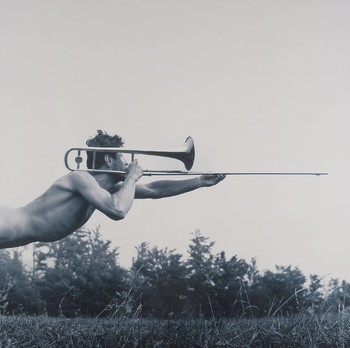
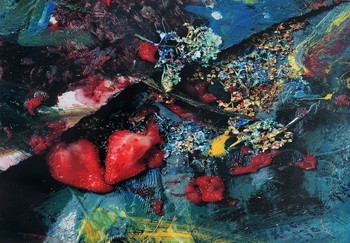
Igor Pustovrh (1961–2011) was a professional photographer with a panache for various genres, such as landscape, portrait, still life and staged photography. In addition to his artistic collections, which earned him a permanent place in the annals of Slovenian photography, he also regularly worked in commercial photography. In his final years, he devoted his creative energy to experimenting with post-production. Starting with his first important series on the subject of the human body from the 1990s (female nudes and portraits in unusual interactions with the environment), he ‘staged’ his compositions, directed those portrayed and placed them in surrealistic situations. Pustovrh is presented at the exhibition with some of his iconic works, which had unveiled a new style of photography to the Slovenian public and brought together a movie-like approach with sensuality and the power of storytelling by creating images reflecting his deep understanding of human sensibilities.
Vladimir Vlastja Simončič
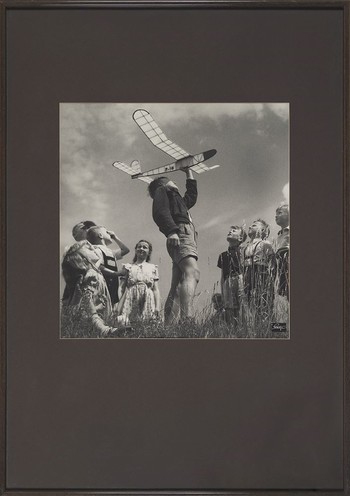
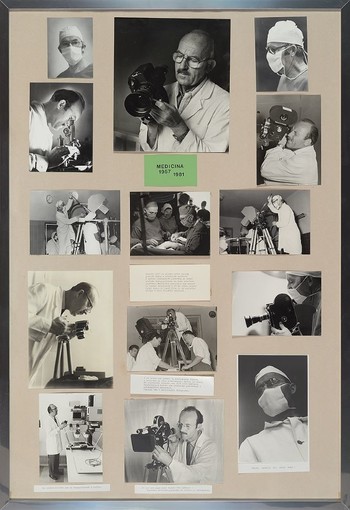
Vladimir Vlastja Simončič (1911–2000) became a professional photographer following WWII, which he spent in the resistance movement and captivity. Constantly improving his skills as a self-taught artist, he worked for newspapers such as Tovariš and Slovenski poročevalec, as well as pursued theatre photography. He was arrested in 1949 during the Informbiro period and sentenced to six months in prison, but, being an established photojournalist, was soon able to continue working for various print media in the 1950s, before specialising in medical photography in 1957. In addition, Simončič was also active in artistic photography, where he focused on landscape and street photography as well as experimented artistically with the photographic medium; he was constantly looking for the ideal balance between a photograph’s composition, contrasts, and meaning. In the 1970s, Simončič moved to Gorenja vas, where he spent some of his most productive artistic years. He set up a private autobiographical museum in the old rectory, thereby also guaranteeing himself an entry in the annals of photography. Simončič’s Vlastja photo sanctuary, where the photos on display here have been taken from, is currently closed. The Škofja Loka Museum and the Municipality of Gorenja Vas–Poljane, however, are preparing a new, permanent exhibition of his collection at the Visoko mansion.
Edi Šelhaus
Edi Šelhaus (1919–2011), one of Slovenia’s most active and celebrated photographers, worked mainly in photojournalism. He was born into a family of photographers – his mother Julijana ran the Šelhaus photography studio in Škofja Loka – so it comes as no surprise that he took a camera along when he joined the partisan resistance movement in 1943, putting it to good use to take bold snapshots on the battlefield. Šelhaus took some of the most iconic WWII photographs in the territory of Slovenia. After the war (1945–1948), he worked as a correspondent from Trieste, and then collaborated with major Slovenian newspapers, such as Delo, Tovariš and Slovenski poročevalec. After 1950, he often visited Škofja Loka, where he took photos of many important political, social and cultural events, including motorcycle races, celebrations at the Veteran’s Association hall, the opening of the town’s bus station, installation of telephone lines or street performances of the Škofja Loka Passion Play. The selection of his photographs shown here focuses mainly on his documentary photography and chronicling of the town’s public life as well as his lucid street and landscape photography.
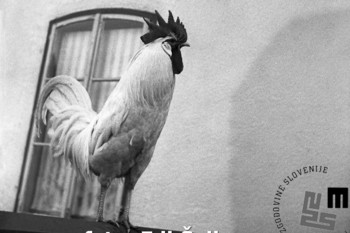
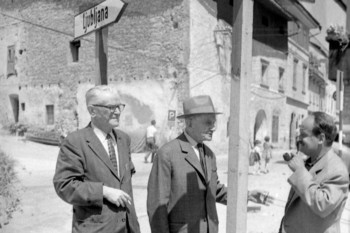
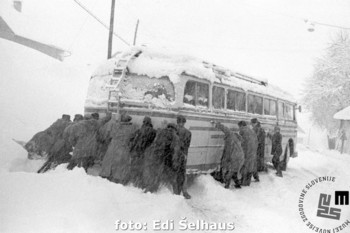

Tone Štamcar
Tone Štamcar (1960) uses a camera not only to record the traces of Škofja Loka's history, but also the town’s contemporary pulse. As a visual chronicler, he highlights the changing diversity of vedutas and the endless stream of personalities that mark, define and co-shape Škofja Loka. Locally, he depicts events of all kinds in a way that goes beyond mere documentary photography. He also tirelessly looks for and investigates new approaches, perspectives and forms of expression, which he then puts into practice in a very personal and direct manner. He directs his efforts on researching carefully selected subjects and, through his sense of detail, confidently serves us scenes from our local environment that we think we know, though in reality our knowledge of them is mainly superficial.

